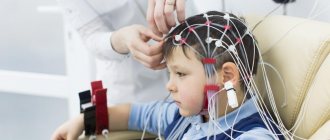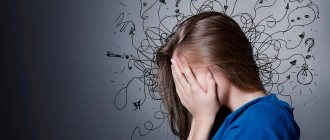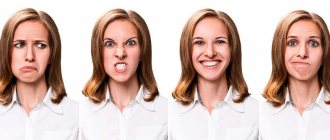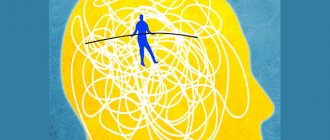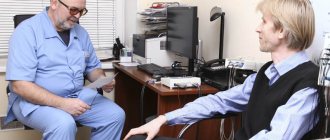Forms of schizophrenia and course
Treatment of schizophrenia - we use soft hospital replacement techniques without the use of psychotropic drugs.
Schizophrenia is a group of diseases characterized by disharmony and loss of unity of mental functions (thinking, emotions, motor skills), a combination of productive (delusions, hallucinations, etc.) and negative (decreased volitional activity, emotional impoverishment, increased introversion, etc.) symptoms, long-term and progressive course, united by a common development mechanism and the same outcome of the disease (development of the so-called schizophrenic defect).
The term schizophrenia has been used since 1911, after E. Bleuler combined the previously observed dementia praecox, hebephrenia, catatonia and chronic delusional psychoses into one disease. Schizophrenia is diagnosed in approximately 1% of the population, with approximately equal prevalence in men and women. This disease affects approximately 45 million people in the world, and it is diagnosed in 4.5 million people every year. In Russia, the incidence and prevalence of schizophrenia are at the world average.
Forms of schizophrenia
- in the form of psychoses with severe mental disorders in the form of delusions, hallucinations, aggressive behavior, freezing;
- in the form of non-rough, so-called borderline disorders (the appearance of obsessive thoughts, mood changes, the appearance of unpleasant sensations in various parts of the body, etc.),
- and also under the guise of subtle personality changes (loss of previous interests, increasing isolation, passion for “occult” knowledge, etc.).
Variants of the course of schizophrenia
- unfavorable forms of schizophrenia, in which the disease, after its onset, proceeds only with progression and leads to the disintegration of personality in a short time (several years)
- a continuous course in which the symptoms of the disease do not stop, there are no temporary lulls.
- paroxysmal course, in which attacks of the disease can be replaced by more or less long periods without painful disorders (remission). Moreover, there are people who have suffered only one attack in their entire lives.
- paroxysmal-progressive course, there is a kind of intermediate type of course, in which increasing personality changes are observed between attacks.
Schizoaffective disorder: drug treatment
Therapy for schizoaffective disorder at Dr. Isaev’s clinic includes the use of medications to relieve symptoms and psychotherapy. If the patient shows severe aggression during an attack, he is hospitalized until a stable condition is achieved. Taking medications is the main form of assistance for this disease, while working with a psychologist is considered no less important, but auxiliary.
To treat and eliminate negative symptoms, the following are usually prescribed:
- antipsychotics, they eliminate delusions, hallucinations and other symptoms of psychosis;
- anxiolytics for sleep disturbances and severe anxiety;
- antidepressants, which stop low mood, apathy, a feeling of uselessness, the desire for one’s own death, encourage action;
- mood stabilizers to normalize mood in case of low mood or manic disorder;
- sleeping pills that help normalize a good night's rest.
Acute psychosis with this deviation is usually treated with a combination of two or more medications. But it is best for the doctor to select a dose with constant observation, and therefore the person needs to stay in the hospital for some time. After achieving remission, the patient begins outpatient treatment with periodic visits to a psychiatrist. He comes to see him or a specialist is called to his home for a routine inspection.
In our clinic, only proven, certified drugs are used to treat schizoaffective disorder. They give the desired result and at the same time have minimal side effects.
If a person has schizoaffective disorder and dependence on alcohol and psychotropic drugs, then in this case a narcologist is involved in the therapy process, since chemical addictions greatly aggravate the condition and reduce the effectiveness of treatment.
Main forms of schizophrenia
Diagnosis of forms of schizophrenia, even in cases of severe painful disorders in the form of psychoses with seemingly obvious schizophrenic symptoms, requires caution. Not all psychoses with delusions, hallucinations and catatonic symptoms (freezing, agitation) are manifestations of schizophrenia. Below are the most specific psychotic symptoms for schizophrenia (the so-called first-rank symptoms).
Openness of thoughts – the feeling that thoughts can be heard from a distance. Feeling of alienation is the feeling that thoughts, feelings, intentions and actions come from external sources and do not belong to the patient.
Feeling influenced - the feeling that thoughts, feelings and actions are imposed by some external forces that must be passively obeyed.
Delusional perception is the organization of real perceptions into a special system, often leading to false ideas and conflict with reality.
Auditory hallucinations are clearly audible voices emanating from inside the head (pseudohallucinations), commenting on the actions or pronouncing the patient’s thoughts.
Differential diagnosis
In cases of acute illness, a doctor can assume schizophrenia based on an examination, conversation with the patient, information from loved ones about how behavioral disorders developed, how the patient behaved. Accurate diagnosis of the form of schizophrenia, especially in cases where the disease is not severe, sometimes requires hospitalization. Modern scientists consider it necessary to monitor the patient for at least a month in order for the diagnosis to be accurate. In these cases, in addition to assessing the history of the disease and the patient’s condition upon admission, the doctor observes the patient’s behavior in the hospital (or day hospital), and also carries out various diagnostic manipulations to exclude other causes of mental disorders.
One of the diagnostically valuable types of examinations is a pathopsychological examination, during which higher mental functions are assessed:
- memory
- attention
- thinking
- intelligence
- emotional sphere
- volitional characteristics
- personal characteristics, etc.
Depending on the manifestations of the disease and its course, several forms of schizophrenia are distinguished:
Paranoid form of schizophrenia
The most common form of the disease. It manifests itself as a relatively stable, usually systematized delusion (persistent false conclusions that cannot be dissuaded), often accompanied by hallucinations, especially auditory ones, as well as other perceptual disturbances. The most common symptoms of paranoid schizophrenia include:
- delusions of persecution, relationship and significance, high origin, special purpose, bodily changes, or jealousy;
- hallucinatory voices of a threatening or commanding nature or auditory hallucinations without verbal expression, such as whistling, humming, laughter, etc.;
- olfactory or taste hallucinations, sexual or other bodily sensations.
Visual hallucinations may also occur. In the acute stages of paranoid schizophrenia, the behavior of patients is grossly disturbed and is determined by the content of painful experiences. So, for example, with delusions of persecution, the sick person either tries to hide, escape from imaginary pursuers, or attack and try to defend himself. With auditory hallucinations of a commanding nature, patients can carry out these “commands”, for example, throw things out of the house, swear, grimace, etc.
Hebephrenic form of schizophrenia
More often, the disease begins in adolescence or young adulthood with a change in character, the appearance of a superficial and mannered passion for philosophy, religion, the occult and other abstract theories. Behavior becomes unpredictable and irresponsible, patients look infantile and foolish (they make ridiculous faces, grimace, giggle), and often strive for isolation. The most common symptoms of hebephrenic schizophrenia include:
- distinct emotional flatness or inadequacy;
- behavior characterized by goofiness, mannerisms, grimaces (often with giggles, smugness, self-absorbed smiles, grand manners);
- distinct thinking disorders in the form of broken speech (violation of logical connections, jumping thoughts, connection of heterogeneous elements not related in meaning);
- hallucinations and delusions may not be present.
To diagnose the hebephrenic form of schizophrenia, it is necessary to monitor the patient for 2-3 months, during which the above-described behavior persists.
Catatonic form of schizophrenia
In this form of the disease, movement disorders predominate, which can vary in extremes from freezing to hyperactivity, or from automatic submission to senseless resistance, the patient’s unmotivated refusal to perform any movement, action or resistance to its implementation with the help of another person. Episodes of aggressive behavior may occur.
In the catatonic form of schizophrenia, the following symptoms are observed:
- stupor (a state of mental and motor retardation, reactions to the environment, spontaneous movements and activity decrease) or mutism (lack of verbal communication between the patient and others while the speech apparatus is intact);
- excitement (purposeless motor activity, not subject to external stimuli);
- freezing (voluntary acceptance and retention of an inadequate or pretentious pose);
- negativism (meaningless resistance or movement in the opposite direction in response to all instructions or attempts to change position or move);
- rigidity (holding a pose in response to an attempt to change it);
- “waxy flexibility” (holding body parts in a given position, even uncomfortable and requiring significant muscle tension);
- automatic obedience;
- getting stuck in the mind of one thought or idea with their monotonous repetition in response to newly asked questions that no longer have anything to do with the original ones.
The above symptoms can be combined with a dream-like state, with vivid scene-like hallucinations (oneiroid). Isolated catatonic symptoms can occur in any other form and other mental disorders. For example, after suffering traumatic brain injuries, in case of poisoning with psychoactive substances, etc.
Causes of schizoaffective disorder
The exact causes of the pathology are unknown, like many other mental disorders, but there are several individual characteristics of the body that increase the likelihood of developing schizoaffective disorder. Most often it is observed in individuals with a hereditary predisposition.
Researchers have identified a risk gene that causes the development of schizophrenia. But under certain conditions, it is in a “dormant state” and begins to manifest itself after exposure to severe stress, severe somatic illness, etc. In addition, the appearance of this gene in the fetus may be due to mutational processes. There is also an assumption of the etiological and pathogenetic similarity of this disease and epilepsy, since in both cases there is a periodicity of manifestations and characteristic changes in the electrical activity of the brain on the EEG.
Provoking factors for the development of schizoaffective disorder can be:
- low social status;
- hunger and poverty;
- hostilities;
- forced migration;
- complete loneliness and lack of help from other people;
- alcohol and drug use.
In the case of the use of psychoactive drugs and alcohol, the possibility of developing this mental disorder increases. At the same time, people with this pathology also often have chemical dependencies, with the help of which they try to get away from their painful sensations, but this only aggravates the process of degradation. To determine what is primary – a mental illness or an addiction to alcohol or drugs, an experienced specialist and monitoring of the patient’s condition in a psychiatric hospital are required.
Dr. Isaev’s clinic has all the conditions for conducting differential diagnosis and providing professional assistance for schizoaffective disorder. For more detailed information, you just need to call the number listed on the website.
Simple forms of schizophrenia
With this form of schizophrenia, oddities and inappropriate behavior gradually develop, and overall productivity and performance decrease. Delusions and hallucinations are usually not observed. Vagrancy, absolute inactivity, and aimlessness of existence appear. This form is rare. To diagnose a simple form of schizophrenia, the following criteria are needed:
- the presence of progressive development of the disease;
- the presence of characteristic negative symptoms of schizophrenia (apathy, lack of motivation, loss of desires, complete indifference and inactivity, cessation of communication due to loss of responsiveness, emotional and social isolation) without pronounced delusional, hallucinatory and catatonic manifestations;
- significant changes in behavior, manifested by a pronounced loss of interests, inactivity and autism (immersion in the world of subjective experiences with weakening or loss of contact with the surrounding reality).
Residual (residual) schizophrenia
In this form, after psychotic attacks of the disease, only negative schizophrenic symptoms persist and continue for a long time: decreased volitional and emotional activity, autism. The patients’ speech is poor and inexpressive, self-care skills, social and labor productivity are lost, interest in married life and communication with loved ones fades, and indifference to relatives and children appears. Such conditions in psychiatry are usually defined as a schizophrenic defect (or the final state of schizophrenia). Due to the fact that with this form of the disease the ability to work is almost always reduced or lost, and patients often need outside supervision, special commissions determine the disability group for patients.
In the residual form of schizophrenia, the following symptoms are observed:
- distinct negative schizophrenic symptoms, that is, psychomotor slowing, decreased activity, emotional flatness, passivity and lack of initiative; poverty of speech, both in content and quantity; poor facial expressions, eye contact, voice modulation and posture; lack of self-care skills and social productivity;
- the presence in the past of at least one distinct psychotic episode that meets the criteria for schizophrenia;
- the presence of a period, albeit once a year, during which the intensity and frequency of significant symptoms such as delusions and hallucinations would be minimal in the presence of negative schizophrenic symptoms;
- absence of dementia or other brain diseases;
- absence of chronic depression and hospitalization, which could explain the presence of negative disorders.


